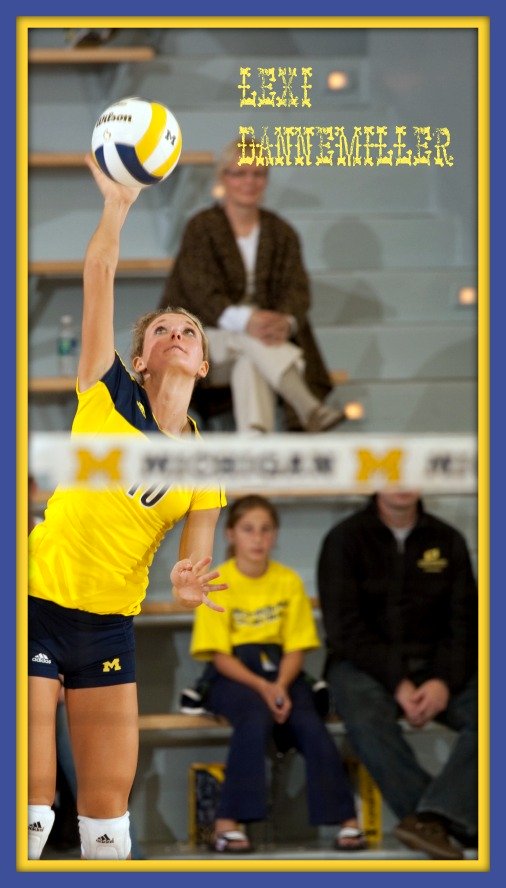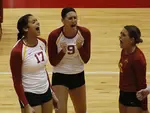- Improve Your Volleyball with Coach April
- Volleyball Court Size
- Volleyball Court Zones
Serving Volleyball Court Zones Score Points With These Serve Tactics
Understanding the different volleyball court zones and selecting the right serving strategy can greatly impact your success in serving points for your team.
Volleyball Court Zones and Serving Strategies
Understanding the different volleyball court zones and selecting the right serving strategy can greatly impact your success in the game.
Let's explore the specific characteristics of each court zone and how you can strategically serve to maximize your chances of scoring points.
1. Position 1 (Right Back):
- This court zone is located in the back-right corner of the court. Serving to Position 1 can be effective in putting pressure on the setter, forcing them to make a difficult pass or limiting their options for setting up an attack. By serving deep into Position 1, you can disrupt the offensive flow and create opportunities for your team to counterattack.
2. Position 2 (Middle Back):
- Positioned in the middle of the back row, serving to Position 2 can be advantageous for targeting the libero or weaker passers. A well-placed serve into Position 2 can force the libero to move quickly and make a tough pass, potentially resulting in an inaccurate or weak set. This can disrupt the opponent's offensive rhythm and give your team an advantage.
3. Position 3 (Left Back):
- Serving to Position 3 can be particularly effective when taller players are in the front row. By serving short to the front row hitter in Position 3, you can limit their ability to execute a powerful attack. The shortened approach gives them less time to generate momentum and jump, reducing the effectiveness of their kill attempts. This strategy can neutralize the height advantage and disrupt the opponent's offense.
4. Position 4 (Middle Front):
- Located in the middle of the front row, serving to Position 4 can target the middle blocker. By serving toward the head of the middle blocker, you can put pressure on their passing skills and force them to make a decision between passing or setting. Additionally, a well-placed serve in Position 4 can create confusion between the two back-row receivers, often causing them to hesitate and potentially resulting in a miscommunication or a weak pass.
5. Position 5 (Right Front):
- Serving to Position 5 can be effective in limiting the options for the outside hitter. By serving deep or short to Position 5, you can disrupt the hitter's approach and timing, making it challenging for them to execute powerful spikes. This strategy forces them to adjust their attack or rely on other hitters, increasing the chances of defensive success for your team.
6. Position 6 (Left Front):
- Finally, serving straight down the middle of the court to Position 6 can be a smart option. By standing in the middle of the baseline and serving towards the back line, you target both the left-back and right-back players in serve receive. This serves as a "divorce maker" ball, challenging both receivers to communicate and make a quick decision, increasing the chances of a miscommunication and creating an opportunity for your team to capitalize on weak passes.
Remember, when selecting your serving strategy, consider the strengths and weaknesses of your opponents, analyze their defensive patterns, and adapt your serve placement accordingly.
By understanding the characteristics of each volleyball court zone and strategically serving to exploit them, you can gain a significant advantage in the game and contribute to your team's success.
Volleyball Zones
Here's why serving to specific volleyball court zones like Position 5, 3 and 6 are important.
- you are the only person who controls the effectiveness of YOUR serve and
- its the one fundamental you can do without the intervention of anyone else to score a direct point with .
...that is very powerful and trust me even many elite players don't take advantage of this unique opportunity.
Volleyball Court Zones:
Why Serve To Position 3
Serve Short to the Middle Front Position 3.
The short serve short to the front row hitter is very effective in girls volleyball.
Many players serve short because it's an option or because it happens by accident but elite volleyball players serve short because they know that the short serve is an equalizer especially when tall players are in the front row.
If the "runway" is cut short...then that "plane" has a hard time taking off. So you the server need to "shorten" the runway way path.
Serve them short while they are in the front row and they won't have time to back up and take their usual long approach.
If they still DO Get the set...they usually don't have the time or the strength to hit as hard or as high as they would if they weren't passing so YOU have effectively helped YOUR team by serving the BIG girl (excuse me TALL girl...I hate when people call me BIG) in the front row...and YOU have intelligently taken her out of the offense.
Volleyball Court Zones:
Why Serve To Position 6
Why should girls who play volleyball always remember this next smart option which is to serve straight down the middle of the court to Position 6?
Instead of serving from either corner of the volleyball court try standing right in the middle of the baseline and serve straight down the middle to the opposite end line.
Usually in the backrow there are two people in serve receive.
Aim for the head of the middle blocker in the front row and serve right towards the back line. Both the left back and right back receivers are forced to decide on or fight over the "divorce maker" ball that goes right down the middle between the two of them.
If done right, the ball will fall right between the two passers and you the server are a HERO not a ZERO!
Don't just go through the motions...remember to practice your individual skill because the ball is in Your hands!
 When coaching girl's volleyball I concentrate alot on the serving fundamentals because of this reason...
you are the only person who controls the effectiveness of YOUR serve and
its the one fundamental you can do without the intervention of anyone else to score a direct point with .
...that is very powerful and trust me even many elite players don't take advantage of this unique opportunity.
When coaching girl's volleyball I concentrate alot on the serving fundamentals because of this reason...
you are the only person who controls the effectiveness of YOUR serve and
its the one fundamental you can do without the intervention of anyone else to score a direct point with .
...that is very powerful and trust me even many elite players don't take advantage of this unique opportunity.This has been an important message by your favorite volleyball coach! That's me!!
Thanks for visiting.
Be sure to check out more of my volleyball articles by clicking one of the links below! (April Chapple)
Do You Follow Me on Pinterest?
Follow me on Pinterest Volleybragswag to improve your game even faster!
I share alot of individual, partner and easy-to-do volleyball serving drills we do in class with my followers.
Many of these volleyball practice drills you can do at home by yourself or try at your next practice with your teammates.
If you're a B team or JV player trying to make varsity next year...your goal should be to complete 1000 reps a day of at least three of the basic skills on your own...volleyball passing, serving and setting should be at the top of the list.
Serving Volleyball Court Zones:
Where Do You Go From Here?
Good times! Where do you need to go now? Here are three options:
- Learn more about the Court Size.
- Follow the suggested reading on our Sitemap page Learning How To Play (Sitemap)
- Or visit the pages in the Volleyball Rules section in the drop down menu at the top of the page.
If your athlete struggles with consistent serve receive, gets subbed out, or is overlooked for playing time—this is the fix you’ve been looking for.

Struggling with passing consistency?
I help talented passers tired of getting pulled from games because of inconsistent serve receive skills BUILD passing confidence without expensive private lessons using the same 3-step system that's helped dozens of my athletes get recruited.
Download my eBook for $17.99 and start building the passing confidence that keeps you on the court—and gets you seen by college coaches.
From Lady Vol to Legend: Coach April Produces Powerful Passionate Players...is that you?
What Are You Looking For?
Click to Download Your Pre Serving Ritual Mastery Checklist pdf:
🎯Volleyball Pre Serving Ritual Guide -
Players! Learn How To Transform Your Serve from Weak to Weapon
Click to Download Your Parent's Volleyball Serving Checklist pdf
🎯Parent's Volleyball Serving Checklist Guide
Parents! Help Your Player Develop Championship Serves (Even If You've Never Played)

Hi there!
Thanks for stopping by. Hope you learned something today that will help you reach your volleyball goals.
Be sure to subscribe to my email newsletter so you can learn more each week!
Stay strong! Stay motivated!
-Coach April

SUSCRIBE to my email newsletter below!
 Click to learn more about the weekly volleyball classes and clinics or email info@imrpoveyourvolley.com for information
Click to learn more about the weekly volleyball classes and clinics or email info@imrpoveyourvolley.com for informationCongratulations to my seven Boys-18s Vegas Volley club players who played in two state championship finals yesterday, the 3A and 5A State champinship finals at Sunrise Mountain High School.
TOURNAMENT CHAMPIONS!
A-1 Vegas Volley VBC
In It To Win It Tournament
May 2 - 4, 2025 Tournament
Gold Medalists
18s Premier Division
Vegas Volleyball's Unsung Heroes: Celebrating Moms with Peace Love Volleyball Shirts
Ready to energize your volleyball mom journey?
Subscribe to my 'Producing Powerful Passionate Peaceful Players' email list above on ImproveYourVolley.com.
You'll receive energy-boosting tips, exclusive insights from me, Coach April Chapple on maintaining momentum in volleyball.
Let's power up the Vegas volleyball scene together!
Recent Articles
-
3 Exercises To Improve Spike Skills By Hitting With A Faster Armswing
Jan 06, 26 01:13 AM
These 3 volleyball exercises to improve spike skills by hitting more balls in the court with a quick armswing and aggressive spike approach to beat blockers. -
Your Serve in Volleyball: 10 Tips To Get You From Bench to Starter
Jan 02, 26 03:41 PM
I hold Tennessee's #2 career aces record (244 aces). Last month I coached 7 players to state finals. These 10 serving tips separate legends from bench players. -
Overhand Jump Serve Volleyball Tips To Score Many More Points and Aces
Jan 02, 26 03:14 PM
My "Coach April Overhand Jump Serve Volleyball Tips" designed to help you increase your serving accuracy, power and the ability to serve more aces in volleyball.
Bestselling
Volleyball Nets
on Sale!


















































